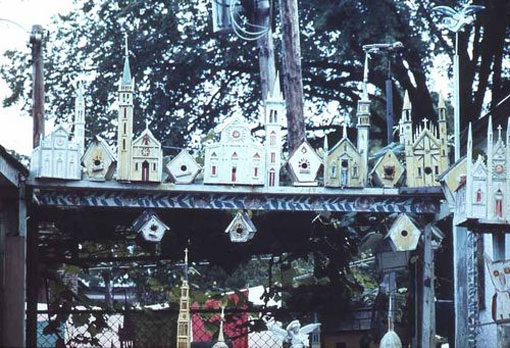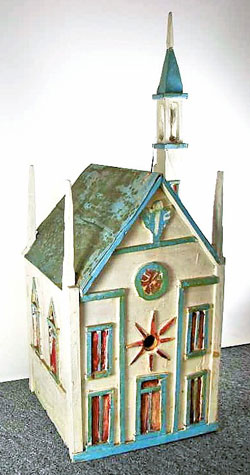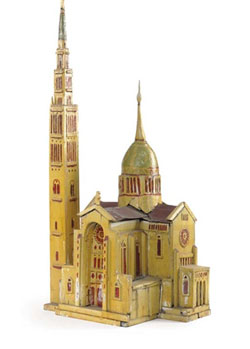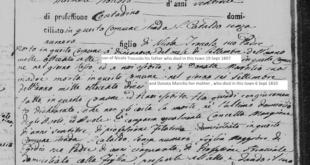 Here in the northern suburbs of Highwood and Highland Park, there has always been an abundance of talented craftsmen, and their imprint remains on many of the grand homes that line the North Shore. From stonemasons to bricklayers, carpenters and gardeners, these men carry an artistic eye, and are meticulous creators in their fields. But none that I know of has achieved the national notoriety of Aldobrando Piacenza (1888-1976).
Here in the northern suburbs of Highwood and Highland Park, there has always been an abundance of talented craftsmen, and their imprint remains on many of the grand homes that line the North Shore. From stonemasons to bricklayers, carpenters and gardeners, these men carry an artistic eye, and are meticulous creators in their fields. But none that I know of has achieved the national notoriety of Aldobrando Piacenza (1888-1976).
Aldobrando Piacenza is acclaimed as an American folk artist who inspired both art students and artists alike. In 2007, his replica of the Shrine of the Immaculate Conception sold at Christie’s Auction house in New York for more than $10,000. He is famous for his “outsider art” of birdhouses modeled in the shape of both famous and simple churches. These are cherished by collectors nationwide. He also painted in primitive folk art style, often on wood surfaces or murals. In the 1960s, art collectors and art students came from the Art Institute of Chicago to visit his home in Highwood to be inspired by his art.
 Born in 1888 in Sant’Anna Pelago, he came from modest means. His parents worked the land and raised cows in an old stone house called Casa del Collo. Before coming to America at a young age, he had spent time with his father’s uncle who was a priest in nearby Fanano. Don Giovanni Battista was the fourth in four generations of priests in the family. Don Fortunato was Aldo’s father’s uncle who also was a priest. Both had great influence on Aldo. Don Fortunato willed his library to the family and it was from there that Aldo was exposed to the classics.
Born in 1888 in Sant’Anna Pelago, he came from modest means. His parents worked the land and raised cows in an old stone house called Casa del Collo. Before coming to America at a young age, he had spent time with his father’s uncle who was a priest in nearby Fanano. Don Giovanni Battista was the fourth in four generations of priests in the family. Don Fortunato was Aldo’s father’s uncle who also was a priest. Both had great influence on Aldo. Don Fortunato willed his library to the family and it was from there that Aldo was exposed to the classics.
Like most family farms in the area, it didn’t produce enough income for the Piacenza household. In those days it was customary for the men to go to work far away to earn money for the family. Aldo and his father went to work in Campiglia, in the gulf of Spezia when Aldo was 14 years old. It was on this trip that they toured the cities of Lucca and Pisa, where Aldo had his first exposure to fine Italian church structures, including the duomo and leaning tower of Pisa.
One month after their return, Aldo set off for America with others from the village in order to find work. In his memoir, which he translated to English in 1959, he described rough seas the entire voyage, “the longest seventeen days of my life.” When he arrived by train to Chicago, he was welcomed by Italian friends from his native village. Even though he was underage, he was able to find work stamping bread loaves at the National Biscuit Company for a salary of $5 per week. Later, he sold strawberries in the streets of Chicago. He became injured when he was hit by a Chicago streetcar while riding his bicycle to work at a bakery. His recovery took four months. From then on he walked with a limp.
He held several different low-skilled jobs, working in hotels, bakeries, and saloons. In 1908 he moved to Highwood, where he took a room and board position at Lake Forest College. In 1918 he served in the U.S. Army. He went back and forth to Italy, often visiting its beautiful cities and their famous churches. At the age of 36 he proposed to Rosina from his village and they married shortly after.
In the late 1920s, he purchased a store at the corner of Highwood Avenue and Green Bay Road in Highwood. It had a soda fountain and he sold sundry items, Italian newspapers, magazines and books. At that time, there were already plenty of Italians living in Highwood, working in nearby Lake Forest and along Sheridan Road. Even though there was an economic depression, his little store prospered. In 1932, Aldo was returning from a trip to Italy and was faced with the notification that the Highwood Bank, where he maintained his accounts, had failed and Aldo had lost all his money. Aldo adorned his Ice Cream Parlour menu with his own original poem commemorating his catastrophe:
Uncertain and burdened by the hard events
Which keep taking place,
Showing very little sympathy for us.
The much-awaited Hoover recovery
Still has not arrived.
On an unusual earthly face,
With an empty wallet in our bosoms.
These bankers dealt with our money
Like garbage collectors.
The happiest are those who have drunk all the money away.
 In 1937, with funds borrowed from the First National Bank of Lake Forest, approved by Vice President Philip Spaidell, he and Rosina purchased a home. They were able to rent out the upstairs apartment to meet most of the mortgage payment. In August 1944, Aldo paid off the mortgage. With the payment, he included a generous thank-you note to Mr. Spaidell and a photo of a “miniature copy model exacted in every detail” of the church and bell tower, his home and barn in Sant’Anna Pelago. He told Mr. Spaidell that the models were on display in front of his Highwood home. This 1944 entry was the first mention of Piacenza’s model building.
In 1937, with funds borrowed from the First National Bank of Lake Forest, approved by Vice President Philip Spaidell, he and Rosina purchased a home. They were able to rent out the upstairs apartment to meet most of the mortgage payment. In August 1944, Aldo paid off the mortgage. With the payment, he included a generous thank-you note to Mr. Spaidell and a photo of a “miniature copy model exacted in every detail” of the church and bell tower, his home and barn in Sant’Anna Pelago. He told Mr. Spaidell that the models were on display in front of his Highwood home. This 1944 entry was the first mention of Piacenza’s model building.
Ruth Horwich, a respected art collector and former chairwoman of the Hyde Park Art Center, had visited the Piacenzas often in the late 1960s. Mrs. Piacenza typically offered up a homemade luncheon and Aldo provided the best Italian wine. Ms. Horwich described Rosina as the stronger personality, taking charge with the organization of the household and Aldo as “shy, retiring in nature, but delighted in showing his workshop and his garden.”
Mr. Piacenza was known around town as being friendly and an extremely intelligent man, even though he had no formal education. His passion was building his intricate birdhouses. He also painted Italian inspired scenery, and according to Ermanno Amidei, who once rented an upstairs apartment from him, “every wall in his house was adorned with his artwork. Every wall had a painting. His yard was filled with birdhouses, which he gave away to friends and visitors. After his passing, his wife gave them away as well.”
Today Aldo is known nationally as a self-taught American folk artist. In 1971, the Hyde Park Art Center held an Aldo Piacenza exhibition. The curator recreated the Piacenza’s backyard, where the birdhouses were raised on poles above the picket-fenced garden. There were 55 birdhouses, which included cathedrals and churches and 55 paintings.
 His birdhouses were created from inexpensive pine or fir wood, which he crafted in his basement workshop, then painted with simple paint colors. As Ermanno remembers, “he had many different wood crafting tools, all in miniature for his purposes.”
His birdhouses were created from inexpensive pine or fir wood, which he crafted in his basement workshop, then painted with simple paint colors. As Ermanno remembers, “he had many different wood crafting tools, all in miniature for his purposes.”
In 1979, after his death, Aldo was featured in an exhibition of “Outsider Art” at the Museum of Contemporary Art in Chicago. Recently, the Highwood Public Library displayed Piacenza’s work. Italians within our community are proud to have one of our own achieve such honorable notoriety.
I would like to thank Ermanno Amidei, Joe Bernardi and Yvonne Pasquesi for their contributions in oral and written information. Much of the information included was obtained from the Dissertation of William F. Brooks Jr., in his candidacy of Master of Arts Degree at New York University, 1995.
 Fra Noi Embrace Your Inner Italian
Fra Noi Embrace Your Inner Italian






